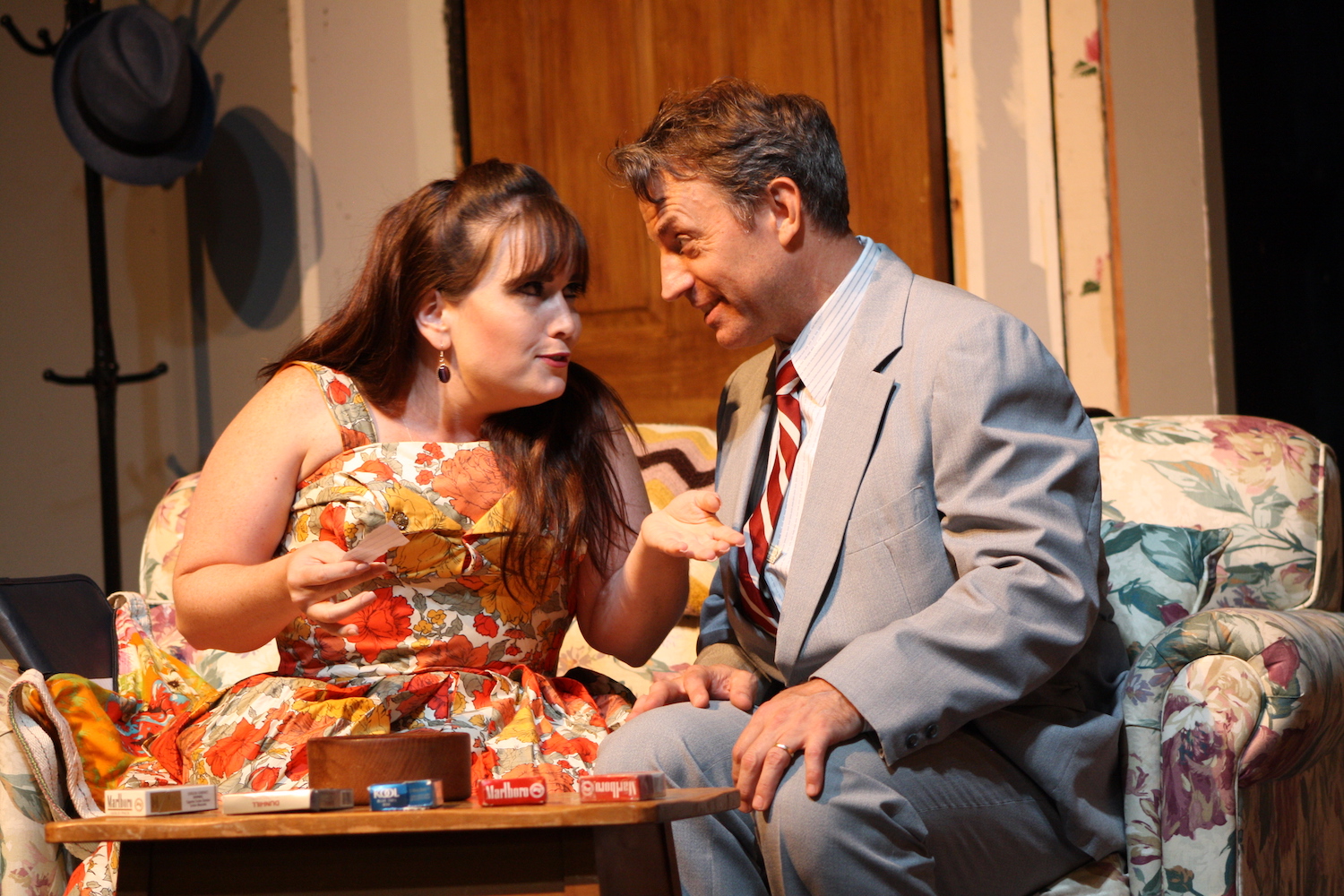
Like the candy of a similar name (available for purchase at concessions), Neil Simon’s Last of the Red Hot Lovers delivers just the right amount of heat and sweet, with an emphasis on the latter.
Ridgefield Theater Barn begins its 54th season with Simon’s ninth play, written in 1969. Last of the Red Hot Lovers sings of the sultry awkwardness of the awakened sexual revolution, and Simon navigates the landscape with his expert humor, vividly actualized characters, and a scoop of misogynistic insensitivity, indicative of the “sexual comedies” of the day. Director Michael Ferrara does a beautiful job in casting four solid actors to play in the world of the Swingin’ Sixties fifty years later with nearly seamless transition.
Simon sets a cast of four characters, centered on the emotional nebbishness of the sole male: Barney Cashman, an unhappy husband desperate for passion and validation from a life too ordinary and a wife too “nice.” Played impeccably by Duane Lanham, Barney breezes and bumbles through three attempts at an affair, each in its own act, each a vastly different “flavor” of woman: disenchanted seductress, ditzy basket case, melancholy housewife, learning as he goes and landing at the appropriate conclusion.
Lanham’s ability to roll with the brilliant dialogue and physical shtick, and make the specific era sound fresh and natural, is a relief to watch. He manages to take long stretches of scripted silence and make them engaging and hilarious without lapsing into hacky clowning. When the set disagrees with the actor’s actions (a hat sails over an established wall into the cosmos, a scene entrance is blocked from a designated doorway) and takes the audience out of reality, he reacts affably and brings the action back to solid space with delightful ease.
Coupled first with Barney is Paulette Layton’s Elaine Navazio. Layton takes a character set up as a sex-positive, relationship-negative seductress archetype and settles her into organic existence. The audience empathizes with her resolute dissatisfaction in a controlling marriage and nearly roots for her to arise victorious from her resigned rejection of romance. She matches Lanham stride for stride with comedic timing and avoids easy and cheap acting choices for such a sexualized character.
The audience rides the humorous heights set by Lanham and Layton into the introduction of Kate Patton making her RTB debut as deceptively ingenuous Bobbi Michele, the antithesis of Elaine’s cynical sass master. Patton maneuvers Bobbi with some difficulty, understandably, given the mental imbalances that Simon imbues her with, and having the bulk of the literary lifting as Bobbi speaks in nearly non-stop monologue. When a character is written as “normal (if eccentric)” on the outside and “crazy” on the inside, it can be a struggle to ground dialogue with any relatability. Patton shifts through the manic stream of consciousness phases of Bobbi with vibrance and projection, if landing a bit on the overacted side. This is completely forgivable, however, as Bobbi herself is an actress who presumably goes through the world with melodramatic flare. WIth this reasoning, one might even dismiss her awkward handling of the rotary phone and stage cigarettes as choices in detaching Bobbi from normative human behavior and leaving her as such a bombastic catalyst to Barney’s evolution.
Through the third act, the audience meets Linda Seay as Barney’s final attempt in extramarital coitus: Jeanette Fisher, a friend of the couple and a presented depressed mess. It is a puzzle why Barney would pursue any chance of getting a hug, let alone intimacy from Jeanette, and the result is an awkward cat and mouse maneuvering around the space. Seay does a magnificent job at taking a one-note character cliche and filling her into an earnest, lovable soul with genuine concerns regarding human connection and happiness.
Herein is where the play shows its mold. In attempt to shake Jeanette from her perception of his lecherous nature, Barney proceeds to--in comedic guise-- scare, threaten, manipulate and presumably rape her. This evokes her exclamations of fright, distress, and capitulation, only to emerge with Barney as triumphant in shifting Jeanette’s mood. He is the underdog hero, complete with beautifully delivered ephiphanic monologue, and is rewarded with Jeanette’s not only affection, but genuine gratitude. The audience responds with laughter and applause, despite the (hopeful) awareness of the inherent flaws in such depictions of sexual interactions; it is on the strength of the performances that the play lands on grounds of solid enjoyment.
RTB, as always, nails the space as period authentic, complete with a groovy soundtrack designed by Erik Donner, a set precisely built by Nick Kaye and decorated by Joanne Gorenstein, and lights designed by Conor Hankla. Costumes are equally perfect, with pieces chosen in that distinctive “New York in the 60s” color palette (think the terracotta, avocado, and mustards of “modern” appliances) by Gina Tonner.
Last of the Red Hot Lovers runs until September 28, 2019 at the Ridgefield Theater Barn, 37 Halpin Lane, Ridgefield, Connecticut. Cabaret style seating. Doors open one hour prior to curtain, which is 8PM evenings and 2PM matinees, and audiences are invited to bring their own food and drink (but not imbibe so much drink that they reply to characters’ dialogue). Tickets are $35 for adults, and $28 for seniors, students and veterans, and available at ridgefieldtheaterbarn.org or by calling the box office at 203- 431-9850. For more information, email info@RidgefieldTheaterBarn.org. Recommended for mature audiences...probably.

